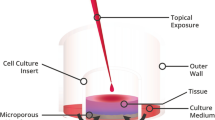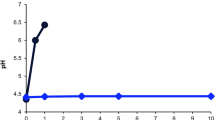Abstract
0,0′-(l,4-Xylylene) bispilocarpic acid esters are pilocarpine pro-drugs containing two pilocarpic acid monoesters linked with one pro-moiety. Each mole of prodrug forms two pilocarpine moles in the presence of esterases. Corneal uptake and permeability of various bispilocarpic acid diesters were investigated in vitro using isolated albino rabbit corneas. The permeability coefficient of pilocarpine was 2.8 × 10 −6 cm/sec, whereas for bispilocarpic acid diesters, despite their large molecular weights (between 638 and 722), permeability coefficients were 6.5–20.2 × 10 −6 cm/sec. Only pilocarpine, and no intact prodrug, was observed at the endothelial side. Corneal uptake was increased with increasing lipophilicity, but a parabolic relationship between the logarithm of the apparent partition coefficient (1-octanol–pH 7.4 phosphate buffer) (log PC) and the corneal permeability was noticed. Corneal permeability and the rate of enzymatic hydrolysis of the compounds correlated well. The corneal permeability of pilocarpine given as lipophilic bispilocarpic acid diester (log PC ≥3) prodrugs seems to be controlled by the formation of pilocarpine in the corneal epithelium rather than by the absorption of prodrugs into the epithelium or their epithelium–stroma transport rate.
Similar content being viewed by others
REFERENCES
F. W. Newell. Ophthalmology. Principles and Concepts, C. V. Mosby, Princeton, NJ, 1986.
C. F. Asseff, R. L. Weisman, S. M. Podos, and B. Becker. Ocular penetration of pilocarpine in primates. Am. J. Ophthalmol. 75:212–215 (1973).
S. S. Chrai and J. R. Robinson. Ocular evaluation of methylcellulose vehicle in albino rabbits. J. Pharm. Sci. 63:1218–1223 (1974).
S. S. Chrai and J. R. Robinson. Corneal permeation of topical pilocarpine nitrate in the rabbit. Am. J. Ophthalmol. 77:735–739 (1974).
S. S. Chrai, T. F. Patton, A. Mehta, and J. R. Robinson. Lacrimal and instilled fluid dynamics in rabbit eyes. J. Pharm. Sci. 62:1112–1121 (1973).
S. S. Chrai, M. C. Makoid, S. P. Eriksen, and J. R. Robinson. Drop size and initial dosing frequency problems of topically applied ophthalmic drugs. J. Pharm. Sci. 63:333–338 (1974).
S. Norell. Medication behavior. A study of outpatients treated with pilocarpine eye drops for primary open-angle glaucoma. Acta Ophthalmol. Suppl. 143 (1980).
M. A. Kass, A. I. Mandell, I. Goldberg, J. M. Paine, and B. Becker. Dipivefrin and epinephrine treatment of elevated intraocular pressure. Arch. Ophthalmol. 97:1865–1866 (1979).
P. D. Krause. Dipivefrin (DPE): Preclinical and clinical aspects of its development for use in the eye. In J. R. Robinson (ed.), Ophthalmic Drug Delivery Systems, Am. Pharm. Assoc., Washington, D.C., 1980, pp. 91–105.
V. H. L. Lee and V. H. K. Li. Prodrugs for improved ocular drug delivery. Adv. Drug Deliv. Rev. 3:1–38 (1989).
G. L. Mosher, H. Bundgaard, E. Falch, C. Larsen, and T. J. Mikkelson. Ocular bioavailability of pilocarpic acid mono-and diester prodrugs as assessed by miotic activity in the rabbit. Int. J. Pharm. 39:113–120 (1987).
G. L. Mosher. Theoretical and Experimental Evaluation of Pilocarpine Prodrugs for Ocular Deliver, Dissertation, University of Kansas, Lawrence.
T. Järvinen, P. Suhonen, S. Auriola, J. Vepsäläinen, A. Urtti, and P. Peura. O,O′-(l,4-Xylylene) bispilocarpic acid esters as new potential double prodrugs of pilocarpine for improved ocular delivery. I. Synthesis and analysis. Int. J. Pharm. (1991), in press.
T. Järvinen, P. Suhonen, A. Urtti, and P. Peura. O,O′-(l,4-Xylylene) bispilocarpic acid esters as new potential double prodrugs of pilocarpine for improved ocular delivery. II. Physicochemical properties, stability, solubility and enzymatic hydrolysis. Int. J. Pharm. (1991), in press.
P. Suhonen, T. Järvinen, P. Peura, and A. Urtti. Permeability of pilocarpic acid diesters across albino rabbit cornea in vitro. Int. J. Pharm. 74:221–228 (1991).
R. D. Schoenwald and H.-S. Huang. Corneal penetration behavior of beta-blocking agents. I. Physicochemical factors. J. Pharm. Sci. 72:1266–1272 (1983).
V. H. L. Lee, K. W. Morimoto, and R. E. Stratford, Jr. Esterase distribution in the rabbit cornea and its implications in ocular drug bioavailability. Biopharm. Drug Disp. 3:291–300 (1982).
R. A. Petersen, K.-J. Lee, and A. Donn. Acetylcholinesterase in the rabbit cornea. Arch. Ophthalmol. 73:370–377 (1965).
Author information
Authors and Affiliations
Rights and permissions
About this article
Cite this article
Suhonen, P., Järvinen, T., Rytkönen, P. et al. Improved Corneal Pilocarpine Permeability with O,O′-(l,4-Xylylene) Bispilocarpic Acid Ester Double Prodrugs. Pharm Res 8, 1539–1542 (1991). https://doi.org/10.1023/A:1015806802973
Issue Date:
DOI: https://doi.org/10.1023/A:1015806802973




